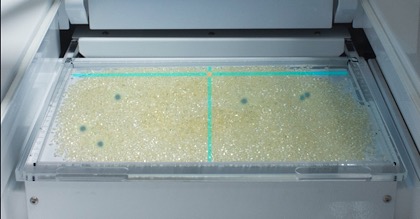 German company “SIKORA” has informed “Polymer Industry Media International” (PIMI) about the company’s new initiative: Combination of light table and automatic sample testing for offline inspection and analysis of the smallest contamination in plastics materials. This info has been submitted to us in the form of anarticle.
German company “SIKORA” has informed “Polymer Industry Media International” (PIMI) about the company’s new initiative: Combination of light table and automatic sample testing for offline inspection and analysis of the smallest contamination in plastics materials. This info has been submitted to us in the form of anarticle.
Introduction
Quality standards in the plastics processing industry present great challenges for plastic manufacturers as well as the processing industry. Inspection and analyzing of raw material before it enters the production process is thus industrial standard. In order to ensure the highest quality of the material and of the final product, plastic manufacturers use online inspection and sorting systems. They inspect the material, detect contaminants, colored anomalies and inhomogeneities in the ongoing production process and automatically sort out contaminated material. Furthermore, systems for sample testing or incoming goods inspection and analysis of plastic material are used. This offline inspection and analysis provides material manufacturers and processors with key information on contamination, the causes of contaminants as well as on their own production processes and is, therefore, essential in future-oriented production lines.
Increasing quality requirements in the plastics industry
Plastics, as they are used in the medical sector or in aerospace and automotive industries, require the highest quality standards as well as a reliable control and processing of raw materials. Contamination may occur during the different process steps for the production of plastic products. During pellet extrusion, for example, cracking in the form of black specks can occur in the material due to temperature peaks. If they enter the further production process, the absolute purity of the final product is no longer guaranteed – sometimes with severe consequences. At the production of medical tubes, contaminants in the raw material lead to a full loss of production. Before production may start again, the whole production line has to be cleaned. Also in the area of injection molding, purity is a crucial criterion. Thus, spray nozzles can block due to contaminants, which may cause high subsistent costs.
Conventional technologies for offline inspection and analysis of plastic material
On the market established technologies for sample testing inspection and analysis of plastic material are subsequently described. A distinction is made between manual light tables and automated optical inspection systems.
Manual light tables are commonly used in the industry for a visual sample testing and incoming goods inspection of plastic material. The material to be inspected is illuminated on a table and manually inspected for contamination by an operator. This time-consuming method depends on the respective auditor. The respective form on the day, experience and amount of time the operator is investing in the inspection of the material are just a few factors that influence the quality of the test result, hence, only a limited repeatability is given. Reflective and highly transparent pellets further complicate the manual visual inspection. Further limits are detectable sizes of contamination for the human eye as well as their classification into size classes.
Alternative optical inspection devices available on the market feed the test material through a hopper and a channel into the inspection area. Thereby, pictures of the material are taken successively. Distinct allocations of contamination to the graphic material as well as a follow-up inspection are not possible.
Optical sample testing with automatic light table system and evaluation
The combination of visual light table and an automatic sample testing is an innovative technology. The operator places the test material on a sample tray. The automatic light table transports the tray with the material through the inspection area, which is equipped with a CMOS line scan color camera. The inspection takes place automatically and within seconds: A projector marks contaminated material directly on the sample tray. Simultaneously, it is displayed and marked on the monitor including information on size and area of the contamination . By analyzing the images, contamination like black specks starting from 50 μm (2 mil) and discolorations are automatically detected, visualized and analyzed in transparent as well as colored or diffuse material. As an alternative to optical technology, a system with X-ray technology is available for the detection of metallic contamination inside as well as on the surface of nontransparent, colored and transparent plastic materials. Individual contaminated pellets can be selected and zoomed in. At the same time, they are optically visualized on the sample tray by cross hairs (home page image). A clear allocation of the contamination and follow-up inspection are always possible and permit new insights regarding the production process.
Statistical evaluation and storage of the measuring values
The presented optical inspection and analysis system contains a specially developed analysis software for the detection, visualization and evaluation of contamination. The software includes an image gallery of detected contamination as well as statistics regarding their size, area and number. Furthermore, previously recorded image material can be imported for follow-up analysis. The inspection and analysis system can be integrated into the company network via a LAN interface in order to export and process collected data. The data provides the users with comprehensive information about the process and the material quality. For example, by establishing a central and constantly updating database, conclusions regarding sources and causes of contamination are possible. On this basis, existing processes in the company or at suppliers can be optimized to ensure a comprehensive quality control.
Application areas of the automatic light table
The described automatic light table offers a broad range of applications. Flakes, micro granulates, films as well as extruded and injection molded parts with a sample height of up to 5 mm (.2”) can be inspected on the sample tray, that has a width of 295 x 210 mm(11.6 x 8.3”) (pictures 3 to 5). For instance, approximately 100 g (.22 lb) pellets can be inspected and analyzed per run. This corresponds to up to 3,300 pellets with a size of 4 x 4 x 4 mm (.16 x .16 x .16”). In addition to the possibility of analysis for determining root causes and process control in classical laboratory, the system is suitable for incoming goods inspection due to its quick automatic analysis within seconds as well as for outgoing goods in order to compare the quality with the customer requirements.
Conclusion
Quality requirements in the production and processing of plastics are continuously increasing whilst the complexity of the production processes is rising simultaneously. In addition to a permanent online monitoring of the production process by inspection and sorting systems, periodic offline sample testing of the plastic material is required in order to ensure a consistent quality from the raw material to the final product. Up to now, manual light tables as well as automated visual inspection devices with no allocation of the contamination and no follow-up inspection for quality assurance, are used as standard in the plastics industry. An innovative optical technology combines the advantages of the manual visual inspection with an automated material sample control. The automatic light table system automatically detects and visualizes contamination from 50 µm (2 mil) and evaluates them statistically. The contamination is clearly allocated and a follow-up inspection is possible at any time. The system is more precise, faster, more reproducible and reliable than the human eye at a light table. Therefore, it largely contributes to quality control and an efficient process optimization.













